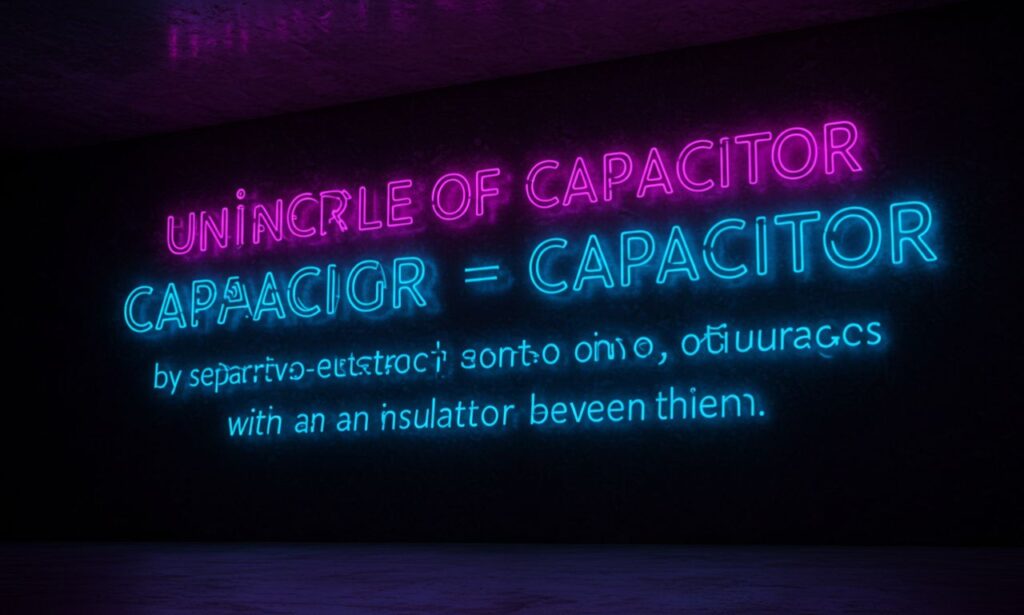The principle of capacitor lies at the heart of modern electronics. Capacitors are components used to store and release electrical energy. Whether in mobile phones, computers, televisions, or electric vehicles, capacitors help regulate voltage, smooth power supply, and manage signal flow.
Capacitors operate on the principle of storing energy in an electric field, which makes them essential in a wide range of circuits. This article explores the working principle of capacitor, its types, real-life applications, and importance in today’s technology.
The Principle of Capacitor: Basic Concept
At its core, the principle of capacitor is based on a device’s ability to store electrical energy between two conductive plates separated by a dielectric (insulating material).
When a voltage is applied across the plates, an electric field develops across the dielectric, causing charges of opposite polarity to accumulate on each plate. Once the power source is disconnected, this energy remains stored in the field until discharged.
Key Formula:
The charge stored in a capacitor is given by:
Q=C×VQ = C \times V
Where:
-
QQ = Charge (in coulombs)
-
CC = Capacitance (in farads)
-
VV = Voltage (in volts)
How the Principle of Capacitor Works in Circuits
1. Charging Phase
When a capacitor is connected to a power source, electrons begin to accumulate on one plate while being removed from the other, creating a voltage difference.
2. Storage Phase
The electric field across the dielectric holds this energy in place. The capacitor is now “charged” and holds potential energy.
3. Discharging Phase
When the circuit requires energy, the capacitor releases stored charge, supplying power and maintaining voltage stability.
The principle of capacitor is fundamentally this charge-storage-release cycle, used across various industries.
Construction of a Capacitor
Capacitors vary in size and form, but all follow the same basic structure:
-
Two conductive plates: Usually made from aluminum or other metals.
-
Dielectric material: Can be ceramic, paper, plastic, mica, or electrolytic fluid.
-
Terminals or leads: For circuit connection.
The choice of dielectric directly affects the capacitor’s capacitance, tolerance, and temperature stability.
Factors Affecting the Principle of Capacitor
Several factors influence how the principle of capacitor is applied in practical scenarios:
-
Capacitance (C) – Determined by the plate area, distance between plates, and dielectric constant.
-
Voltage Rating – Maximum voltage a capacitor can handle.
-
Leakage Current – The small current that may pass through the dielectric.
-
Equivalent Series Resistance (ESR) – Represents losses inside the capacitor.
These factors must be considered during capacitor selection in a circuit.
Types of Capacitors Based on Principle
There are several types of capacitors, each leveraging the principle of capacitor in slightly different ways:
1. Electrolytic Capacitors
-
High capacitance
-
Used in power supplies
-
Polarized; must be correctly oriented
2. Ceramic Capacitors
-
Low cost and small size
-
Non-polarized
-
Used for high-frequency applications
3. Tantalum Capacitors
-
Stable performance
-
Smaller than electrolytic types
-
Ideal for compact electronics
4. Film Capacitors
-
Durable and non-polarized
-
Common in audio and automotive systems
5. Supercapacitors
-
Extremely high capacitance
-
Used in memory backup and energy harvesting
Each type applies the principle of capacitor uniquely based on its construction and material.
Real-World Applications of the Principle of Capacitor
Capacitors are integral to almost every electronic system. Here’s how the principle of capacitor is used in real-world applications:
1. Power Supply Smoothing
Capacitors filter out voltage fluctuations in power supplies, ensuring smooth current delivery.
2. Signal Processing
In radios and televisions, capacitors block DC while allowing AC signals to pass, enabling clear signal transmission.
3. Motor Starters
Used to provide the necessary phase shift and torque to start single-phase motors.
4. Energy Storage
Supercapacitors store large amounts of energy for short-term backup power in electronics.
5. Timing Circuits
Capacitors combined with resistors form RC circuits used for timing applications in alarms, flashing lights, and oscillators.
Role of the Principle of Capacitor in AC and DC Circuits
In DC Circuits:
Capacitors charge up to the applied voltage and then act as open circuits. Their role is usually energy storage or decoupling (removing noise).
In AC Circuits:
Capacitors continuously charge and discharge, allowing AC signals to pass but blocking DC. They are essential in filters and audio applications.
Energy Storage Based on the Principle of Capacitor
The energy stored in a capacitor is calculated using:
E=12CV2E = \frac{1}{2} C V^2
This energy can be released instantaneously, which is why capacitors are used in camera flashes, defibrillators, and high-speed pulsed circuits.
Advantages of Using the Principle of Capacitor
Applying the principle of capacitor brings several benefits:
-
Rapid Energy Storage and Release – Ideal for pulsed systems
-
Noise Reduction – Filters electrical noise from signals
-
Voltage Stabilization – Smooths power in electronics
-
Compact and Lightweight – Easily integrated into devices
-
Long Lifespan – Minimal maintenance and high reliability
Limitations of the Principle of Capacitor
While capacitors are highly useful, the principle also has limitations:
-
Limited Energy Capacity – Compared to batteries
-
Leakage Over Time – May slowly discharge even when not in use
-
Voltage Sensitivity – Exceeding rated voltage can cause damage
-
Polarity Issues – Electrolytic types must be connected correctly
Designers must carefully match capacitors to application needs.
The Principle of Capacitor in Modern Technologies
The principle of capacitor plays a growing role in evolving technologies such as:
1. Renewable Energy Systems
Capacitors store energy from solar panels and wind turbines to stabilize output.
2. Electric Vehicles (EVs)
Used in regenerative braking and onboard electronics for power management.
3. Wireless Communication
Capacitors filter signals in mobile phones, routers, and satellite systems.
4. IoT Devices
Miniature capacitors manage power and data flow in smart devices and sensors.
Future Trends in Capacitor Technology
Advancements in materials science and nanotechnology are enhancing the principle of capacitor in the following ways:
-
Higher Capacitance per Volume – Using graphene and other nanomaterials
-
Flexible Capacitors – For wearable electronics
-
Integration with Microchips – For energy-efficient processors
-
Eco-friendly Dielectrics – Reducing environmental impact
These innovations aim to increase efficiency, energy density, and environmental sustainability.
Tips for Using Capacitors in Circuits
-
Always match voltage rating higher than your circuit’s max voltage.
-
Discharge capacitors before handling to avoid shocks.
-
Use bypass capacitors near ICs to prevent signal issues.
-
Test with a multimeter to ensure functionality.
-
Observe polarity for electrolytic capacitors to prevent failure.
Following these tips ensures the safe and effective application of the principle of capacitor.
Conclusion: Importance of the Principle of Capacitor
Understanding the principle of capacitor is crucial for anyone involved in electronics. Whether it’s powering a tiny LED or managing complex energy flows in electric cars, capacitors make modern electronics efficient, reliable, and powerful.
By learning how capacitors store and manage electrical energy, engineers and hobbyists alike can design better circuits, solve voltage problems, and push technology forward.







